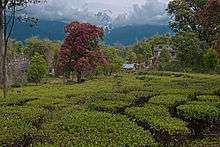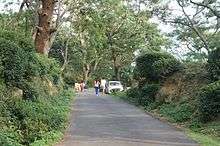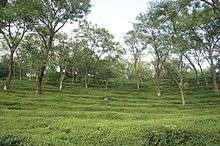Kangra tea

Kangra tea is a tea from the Kangra district in Himachal Pradesh, India. Both black tea and green tea have been produced in the Kangra Valley since the mid-19th century. Kangra tea was given the Geographical Indication status in 2005.
History
Tea was first grown in the Kangra region in the mid-19th century. After a feasibility survey in 1848 showed the area of being suitable for tea plantation, a Chinese variety of Camellia sinensis was planted across the region. The production turned out to be successful in Palampur and Dharamshala, despite failing in other locations.[1] By the 1880s, the Kangra tea was considered to be superior to tea from other places, and was bought in Kabul and Central Asia. In 1882, the Kangra District Gazette described Kangra tea as "superior to that produced in any other part of India."[2] In 1886 and 1895, the tea received gold and silver medals at International conventions held in London and Amsterdam.[2]

However, the 1905 Kangra earthquake caused thousands of deaths and destruction of factories, forcing the British to sell the plantations and leave the area. In the decades that followed, only small quantities of Kangra tea were produced by the new owners.[3]
After a further decline of produce in the 21st century, research and techniques are being promoted, aimed at reviving the brand by increasing the produce.[4][5][6] In 2012, the then Union Minister for Commerce & Industry, Anand Sharma, laid the foundation stone for the Palampur regional office of the Tea Board of India, marking a significant step towards the re-integration of the Kangra region into the mainstream of the Indian tea industry.[7]
Description
Although Kangra cultivates both black tea and green tea, black tea constitutes around 90 percent of the production. As of May 2015, there are 5,900 tea gardens in the area covering about 2,312 hectares of land between Dharamsala, Shahpur, Palampur, Baijnath and Jogindernagar; with an annual output of 8.99 lakh kg.[8] Some of the family owned tea estates like the Mann Tea Estate, run by the Dharmsala Tea Company, also produce specialty teas such as hand rolled oolong tea and silver needle white tea[9] along with other blends such as Rose tea and Saffron green tea.

Kangra tea is known for its unique color and flavor.[8] The unique characteristics of the tea is attributed to the geographical properties of the region.[3] It was granted the Geographical Indication tag in 2005 by Office of the Controller-General of Patents, Designs and Trademarks, Chennai, as per Geographical Indications of Goods (Registration and Protection) Act, 1999.[10]
Flavour is indeed the unique selling proposition of Kangra tea. The Chinese hybrid variety grown here produces a very pale liquor, which is the reason why Kangra does not produce any CTC (crushed, turned, curled) tea—the staple tea of India.[11]
Estates
There are several large tea estates, combined with small holdings, in Kangra. One of the oldest tea companies since the 1880s is the Dharmsala Tea Company, owned by the Mann family. The Dharmsala Tea Company owns three tea estates in and around Dharamsala - Mann Tea Estate, Hoodle Tea Estate and the highest altitude one, the Towa Tea Estate (at roughly 6,500 ft). All the tea estates are at an altitude of 4,000 to 6,500 ft.

The other popular tea estates in the region include the Wah Tea Estate, Palampur tea estates and the Darang Tea Estate.
Tea tourism
Tea tourism is slowly beginning to gain ground in and around Kangra. Several of the tea estates and tea factories in Palampur and Dharamsala offer factory tours as well as home stays for those interested in learning more about the tea. The Dharmsala Tea Company offers guided tours of its factory and tea gardens, starting from its factory in Mann Tea Estate. Similarly, the Palampur Cooperative Tea Factory offers factory tours and home stays.
See also
- Dharmsala Tea Company
- Darjeeling tea
- Nilgiri tea
- Assam tea
- Tea Board of India
- Dharamshala
- Kangra Valley
References
- ↑ "Industry legend Kangra Tea declines on poor returns". Economic Times. 13 October 2010. Retrieved 26 January 2016.
- 1 2 "Tea, the Kangra way". The Hindu. 2014-06-17. ISSN 0971-751X. Retrieved 2016-06-24.
- 1 2 Menon, Aparna (16 June 2014). "Tea, the Kangra way". The Hindu. Retrieved 26 January 2016.
- ↑ Bharadwaj, Ajay (13 January 2006). "Can Kangra's tea regain its old flavour?". DNA India. Retrieved 26 January 2016.
- ↑ Sanyal, Santanu (8 April 2012). "Tea Board steps to boost output, exports of Kangra tea". The Hindu Business Line. Retrieved 26 January 2016.
- ↑ Gulati, Vishal (18 June 2010). "Kangra Tea is set for another bloom". The New Indian Express. Retrieved 26 January 2016.
- ↑ "Tea Board of India". www.teaboard.gov.in. Retrieved 2016-06-24.
- 1 2 Chauhan, Pratibha (20 May 2015). "Kangra tea to get Europeon GI tag soon". The Tribune. Retrieved 26 January 2016.
- ↑ "Himalayan White Tea". Dharmsala Tea Company. Retrieved 2016-06-24.
- ↑ "State Wise Registration Details of G.I Applications" (PDF). Geographical Indication Registry. p. 1. Archived from the original (PDF) on 1 February 2016. Retrieved 26 January 2016.
- ↑ "Kangra Tea | Turning a new leaf - Livemint". www.livemint.com. Retrieved 2016-06-24.